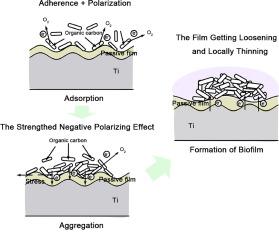Journal of Materials Science & Technology ( IF 11.2 ) Pub Date : 2024-06-15 , DOI: 10.1016/j.jmst.2023.10.066 Z.C. Hu , X.X. Wei , B. Zhang , D.K. Xu , G.T. Zhang , K. Tang , X.L. Ma

|
The formation of biofilm is generally known as a dominant factor for microbiologically influenced corrosion (MIC), and the mechanism of metal corrosion caused by microorganisms through extracellular electron transfer (EET) is widely recognized. Some investigations have discussed the interaction between bacteria and passive film, and oftentimes, not directly corroborated by experimental evidence. Here, we show the structural and compositional evolution of the passive films when interacting with Shewanella oneidensis MR-1. By means of aberration-corrected transmission electron microscope (Cs-corrected TEM) and electron energy loss spectrometer (EELS) analysis, we directly capture the loosening and locally thinning of the passive film induced by Shewanella oneidensis MR-1 and clarify that the passive film has undergone the electrochemical reducing process. This work provides new insights into the EET mechanism between microorganisms and metals.
中文翻译:

使用像差校正 TEM 检测希瓦氏菌 MR-1 诱导的钝化膜的结构演化
生物膜的形成通常被认为是微生物影响腐蚀(MIC)的主导因素,微生物通过细胞外电子转移(EET)引起金属腐蚀的机制已得到广泛认可。一些研究讨论了细菌和钝化膜之间的相互作用,但通常没有得到实验证据的直接证实。在这里,我们展示了与 Shewanella oneidensis MR-1 相互作用时钝化膜的结构和成分演变。通过像差校正透射电子显微镜(Cs校正TEM)和电子能量损失谱仪(EELS)分析,我们直接捕获了Shewanella oneidensis MR-1引起的钝化膜的松动和局部减薄,并阐明了钝化膜经历了电化学还原过程。这项工作为微生物和金属之间的 EET 机制提供了新的见解。











































 京公网安备 11010802027423号
京公网安备 11010802027423号